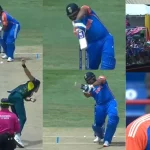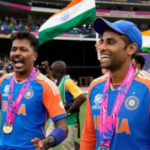India’s upcoming white-ball tour of Sri Lanka has sparked considerable debate, primarily due to the exclusions of Sanju Samson, Abhishek Sharma, and Yuzvendra Chahal. As the cricketing world prepares for the T20I and ODI series, starting on July 27 and August 3 respectively, former cricketer Harbhajan Singh has publicly voiced his disappointment over the squad selections. This article delves into the contentious omissions, the rationale behind the decisions, and the implications for the players and Indian cricket as a whole.
The Disappointing Exclusions: Samson, Sharma, and Chahal
Harbhajan Singh’s Reaction
Harbhajan Singh took to social media to express his bewilderment at the exclusion of Sanju Samson, Abhishek Sharma, and Yuzvendra Chahal. In a tweet, Harbhajan stated, “Hard to understand why Yuzvendra Chahal, Sanju Samson, and Abhishek Sharma are not a part of the Indian team for Sri Lanka.” His sentiment echoes the confusion and frustration felt by many fans and cricket experts.
Sanju Samson: Inconsistent Opportunities
Sanju Samson, despite being a promising talent, has faced inconsistent selection throughout his career. Recently, he scored his maiden international hundred in December 2023 but was dropped from the ODI squad for the Sri Lanka series. Samson’s exclusion seems puzzling, especially considering his recent form and potential as a reliable middle-order batsman. While he has been included in the T20I squad, his omission from the ODIs raises questions about his future in India’s plans, particularly with the Champions Trophy on the horizon.
Abhishek Sharma: A Rising Star Overlooked
Abhishek Sharma, who scored a rapid century in only his second international appearance against Zimbabwe, was surprisingly dropped from the T20I squad. The young all-rounder’s exclusion is particularly controversial given his recent performances and potential to contribute both with the bat and ball. His aggressive batting style and handy left-arm spin could have provided valuable options for India in the upcoming series and beyond.
Yuzvendra Chahal: End of an Era?
Yuzvendra Chahal’s omission from both the T20I and ODI squads has sparked speculation about the end of his white-ball career. Chahal, who was part of India’s T20 World Cup squad last month, has been a mainstay in the Indian bowling lineup for years. With fellow wrist-spinner Ravi Bishnoi being preferred for the Champions Trophy, and Chahal turning 35 before the next T20 World Cup in 2026, his future in the Indian team looks uncertain.
Suryakumar Yadav: The New T20I Captain
Suryakumar Yadav’s Appointment
Amidst the controversy over the exclusions, Suryakumar Yadav’s appointment as the T20I captain has been a significant development. Yadav, known for his explosive batting and calm demeanor, has been entrusted with leading the team against Sri Lanka. His leadership style, similar to Rohit Sharma’s, emphasizes strong communication and individual player development, which has garnered the trust of his teammates.
Hardik Pandya: From Leader to Vice-Captain
Hardik Pandya, who was seen as the natural successor to Rohit Sharma, has been sidelined in favor of Yadav. Despite his impressive performances and leadership in the past, Pandya’s recurring fitness issues and recent poor IPL campaign have led to doubts about his suitability as a captain. This decision highlights the BCCI’s preference for stability and reliability in leadership, particularly with the T20 World Cup looming.
The Selection Committee and New Head Coach’s Influence
Gautam Gambhir’s Vision
The newly-appointed head coach, Gautam Gambhir, and chief selector Ajit Agarkar have played pivotal roles in shaping the squad. Gambhir’s vision for stability and effective workload management influenced the decision to appoint Yadav as captain. He preferred a leader who could consistently perform and maintain fitness, criteria that Yadav meets more comfortably than Pandya.
Ajit Agarkar’s Strategic Decisions
Ajit Agarkar’s influence is evident in the selection of Ravi Bishnoi over Chahal and the emphasis on all-rounders in the squad. The focus on building a team for the future, with an eye on the Champions Trophy and beyond, has led to these strategic decisions. Agarkar’s approach aligns with Gambhir’s, emphasizing the need for a balanced and reliable squad.
The Impact on Indian Cricket
Long-Term Vision
The selections and exclusions reflect a broader vision for Indian cricket, focusing on building a team that can perform consistently in major tournaments. While the immediate reactions may be of disappointment and confusion, the long-term strategy aims to prepare a robust squad capable of handling various challenges.
Player Development and Opportunities
For players like Samson and Sharma, the current exclusions may serve as a motivation to further prove their mettle in domestic and other international opportunities. Chahal’s situation, though more complex, underscores the competitive nature of selection in Indian cricket, where consistent performance and fitness are paramount.
Navigating Controversial Selections
The Indian cricket team’s selection for the Sri Lanka tour has sparked significant debate, highlighting the challenges and intricacies of forming a balanced and effective squad. While Harbhajan Singh’s criticism reflects a widespread sentiment, the decisions by the BCCI, influenced by the new head coach and selection committee, aim to build a team prepared for future challenges. As India embarks on this tour, the performances of the selected players will be closely watched, providing insights into the success of these controversial decisions.
Please check for information on the best betting sites in India – https://selectory.org/best-betting-sites/















